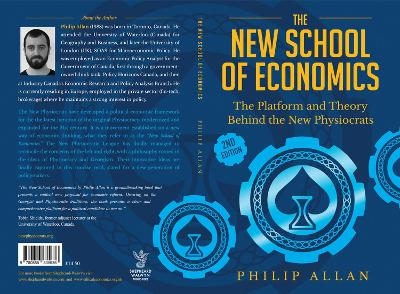
The New School of Economics
Shepheard-Walwyn (Publishers) Ltd (Verlag)
978-0-85683-563-6 (ISBN)
The New School of Economics offers a coherent plan to transform our current confining and unjust economic system into a fair and prosperous economics with opportunities for all. This book addresses systematic issues and offers a roadmap to overcome denied access to prosperity, by creating a more just and vibrant society where everyone has an opportunity to thrive and find fulfilment. The author introduces a more simplified introduction to the world of Physiocracy, and the physiocrats, the 18th century group of economists who believed that the wealth of nations derived solely from the value of ‘land agriculture’ or ‘land development’ and that agricultural products should be highly priced. At the center of this book is the movement of a new way of economic thinking. With their political-economic framework, The New Physiocrats refer to this as the ‘New School of Economics’. The New School of Economics presents many opportunities for lively debate. Especially now, when the whole banking system is about to collapse. The author presents an entirely new banking and tax system that is a much fairer distribution of resources and their allocation than ever before.
Philip Allan (1988) was born in Toronto, Canada. He attended the University of Waterloo (Canada) for Geography and Business, and later the University of London (UK), SOAS for Macroeconomic Policy, He was employed as an Economic Policy Analyst for the Government of Canada, first through a government-owned think tank, Policy Horizons Canada, and then at Industry Canada’s Economic Research and Policy Analysis Branch. He is currently residing in Europe, employed in the private sector (fin-tech, brokerage) where he maintains a strong interest in policy.
Prologue x
Update & Reflection: xvi
Introduction The Dream 1
Who are the New Physiocrats? 2
The Decline of Current Market-based Models 3
Part I: The Guiding Principles of the New School 7
Georgism’ s Pragmatic Land Value Tax 10
Modern-Day Examples 14
The New Physiocratic Platform 14
Our Flag 15
Part II: Economic Reform Platform 17
The Three Pillars of Income Security 17
Commons Levies for the National Dividend 19
Lessons Learned and Property Bubbles 20
Unified Location Tax (ULT) 22
Environmental Taxation 27
Returning the Money You Earned 28
The New Management Incentives 30
Monopolies and Public-Private Partnerships 32
Sustainable Value Added Tax (SVAT) 33Types of Consumption 34
Focus on Purchasing Power 35
Sectoral Banks 36
Business-to-Business Portal 46
The Effort to Support Purchasing Power — Benefit Licenses 47
Table of Contents
Community Restaurants, Cultural Clothing, and Groceries 48
Local Markets 49
Consumers and Farmers Shops 51
The New Rules for Industrial Organization: The Problems with Picking Winners 51
Static, Dynamic, and Traditional Sectors 52
Visual Space 55
The New Rules for a Functioning Market: Guardians ofTransparency 56
Private Property 57
The Path to Full Employment 58
The Effort to Restore Our Time 58
Bankruptcy 60
Perfect Information and Perverse Incentives: Publish salaries,education availability 60
Industry-Managed Rapid Retraining (IMRR) 61
Employer of Last Resort 62
Freeing the Labor Market from its Distortions 63
Sustainable Pensions and Savings 64
The New Rules for Trade: Protectionism vs. Compensatism 66
Preferential Trade Agreements 71
Planned Obsolescence 71
Economic Complexity 72
Chilean-style capital controls 72
The New Rules on Government Spending 73
Focus on Incentives 75
Part III: Political Reform Platform 76
A New System of Government 76
Financial and Monetary Reform 81New Central Bank Rules and Tools 85
Part IV: Social Reform Platform 87
Culture and Free Speech 87
Marriage and Child-rearing 87
Our Space and Health 91
Our Space and Education 92
Scale & Efficiency versus Diversity & Safety 93
Wasted Legal Efforts 94
A New Metric for Success 96
Part V: The Constitution — The General Agreement 98
The New Physiocratic Platform 99
Social Reform: 101
The Road to Power 105
Glossary 107
Annex I 110
Annex II 120
| Erscheinungsdatum | 03.08.2023 |
|---|---|
| Sprache | englisch |
| Maße | 152 x 229 mm |
| Themenwelt | Sozialwissenschaften ► Politik / Verwaltung ► Staat / Verwaltung |
| Sozialwissenschaften ► Soziologie | |
| Wirtschaft ► Volkswirtschaftslehre ► Makroökonomie | |
| Wirtschaft ► Volkswirtschaftslehre ► Wirtschaftspolitik | |
| ISBN-10 | 0-85683-563-3 / 0856835633 |
| ISBN-13 | 978-0-85683-563-6 / 9780856835636 |
| Zustand | Neuware |
| Informationen gemäß Produktsicherheitsverordnung (GPSR) | |
| Haben Sie eine Frage zum Produkt? |
aus dem Bereich


